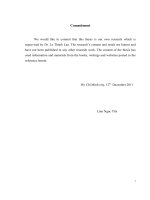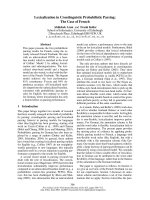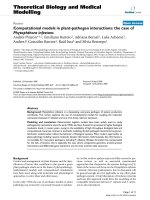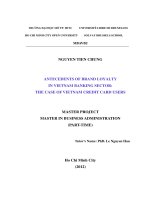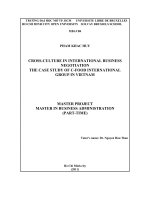Application of strategic management in marketing strategic formulation the case of UDIC
Bạn đang xem bản rút gọn của tài liệu. Xem và tải ngay bản đầy đủ của tài liệu tại đây (1.4 MB, 113 trang )
vietnam national university, HANOI
school of business
Chu Thi Phuong Thao
Application of strategic management in
Marketing strategy formulation
the CASE OF udic
master of business administration thesis
Hanoi - 2007
vietnam national university, HANOI
school of business
Chu Thi Phuong Thao
Application of strategic management in
Marketing strategy formulation
the CASE OF udic
Major: Business Administration
Code: 60 34 05
Master of business administration thesis
Supervisors:
1. Nguyen Thi Phi Nga, PhD
2. Dang Ngoc Su, MBA
Hanoi – 2007
ix
TABLE OF CONTENTS
ACKNOWLEDGEMENTS I
ABSTRACT II
TÓM TẮT IV
LIST OF ABBREVIATIONS VI
LIST OF FIGURES, GRAPHS AND TABLES VII
TABLE OF CONTENTS IX
INTRODUCTION 1
1. THE RATIONALE 1
2. OBJECTIVES AND AIMS 2
3. RESEARCH QUESTIONS: 3
4. SCOPE OF WORK 3
5. DATA SOURCES AND PROCESSING 3
6. RESEARCH METHODOLOGY 3
7. SIGNIFICANCE 3
8. LIMITATIONS: 4
9. EXPECTED RESULTS 4
10. FOLLOW-UP POTENTIAL 4
11. STRUCTURE OF THE THESIS 4
CHAPTER 1 6
THEORETICAL FOUNDATION 6
1.1 STRATEGY AND MARKETING STRATEGY 6
1.1.1 STRATEGY 6
1.1.2 MARKETING STRATEGY 8
1.2 THE IMPORTANCE OF MARKETING STRATEGY 9
1.2.1 MARKETING STRATEGY’S ROLE IN CORPORATE STRATEGY 9
1.2.2 MARKETING STRATEGY’S ROLE IN SECTORIAL TATICS AND ACTIONS 10
1.2.3 THE IMPORTANCE OF MARKETING STRATEGY TO THE REAL ESTATE 11
1.3 STRATEGIC MARKETING PLANNING 11
1.3.1 STRATEGIC PLANNING AND ITS IMPLICATION FOR MARKETING 12
1.3.2 STRATEGIC MARKETING PLANNING MODEL 13
1.4 BEST PRACTICES OF STRATEGIC MARKETING PLANNING 23
CHAPTER 2 28
STATUS OF UDIC’S STRATEGIC MARKETING PLANNING FOR THE REAL ESTATE 28
2.1 BACKGROUND 28
2.1.1 GENERAL INTRODUCTION 28
2.1.2 ORGANIZATIONAL STRUCTURE 29
2.1.3 SCOPE OF BUSINESS 31
2.1.4 NOBLE AWARDS 31
2.1.5 INVESTMENT PROJECTS 32
2.2 STATUS OF UDIC’S STRATEGIC MARKETING PLANNING FOR THE REAL ESTATE 35
2.2.1 REVIEW OF UDIC’S STRATEGIC MARKETING PLANNING 35
2.2.2 APPLICATION OF THE STATED MODEL OF STRATEGIC MARKETING PLANNING FOR
UDIC’S REAL ESTATE 37
CHAPTER 3 39
FORMULATION AND CHOICE OF APPROPRIATE MARKETING STRATEGIES FOR UDIC’S
REAL ESTATE 39
x
3.1 VISION, MISSION STATEMENTS AND STRATEGIC OBJECTIVES 39
3.1.1 VISION: 39
3.1.2 MISSIONS: 39
3.1.3 STRATEGIC OBJECTIVES 39
3.2 TARGET MARKET 39
3.3 SCANNING THE EXTERNAL ENVIRONMENT 40
3.3.1 MACRO ENVIRONMENT 40
3.3.1.1 Economic environment 40
3.3.1.2 Political-Legal environment 45
3.3.1.3 Demographic environment 45
3.3.1.4 Social environment 46
3.3.1.5 Global environment 47
3.3.1.6 Technological environment 48
3.3.1.7 Opportunities, threats and their rankings from macro analysis 48
3.3.2 MICRO ENVIRONMENT 51
3.3.2.1 Market overview 51
3.3.2.2 Industry analysis 56
3.4 INTERNAL ENVIRONMENT 66
3.5 SWOT MATRIX 82
3.6 POSITIONING 85
3.7 FORMULATION AND SELECTION OF APPROPRIATE STRATEGIES 87
3.7.1 TOWS MATRIX 87
3.7.2 GREAT 88
3.8 MARKETING MIX 90
3.8.1 PRODUCT 90
3.8.2 PRICE 92
3.8.3 PROMOTION 94
CHAPTER 4 97
MEASURES TO IMPLEMENT THE SELECTED STRATEGIES 97
4.1 MARKETING ORGANIZATION 97
4.1.1 SETTING UP A MARKETING DEPARTMENT 98
4.1.2 CLOSE COORDINATION WITH OTHER DEPARTMENTS TO IMPLEMENT THE SELECTED
STRATEGY 100
4.1.3 BUILDING UP A COMPANYWIDE MARKETING ORIENTATED SPIRIT 100
4.1.4 INJECTING MORE CREATIVITY INTO THE ORGANIZATION 102
4.2 MARKETING IMPLEMENTATION 102
4.3 MARKETING EVALUATION AND CONTROL 102
CONCLUSION 104
REFERENCES 106
vi
LIST OF ABBREVIATIONS
CBRE
CB Richard Ellis (International property consultants)
GDP
Gross domestic product
GREAT
Gain, risk, expense, achievable and time-bound
ISO 9001:2000
International Standard Organization 9001:2000
SWOT
Strengths, weaknesses, opportunities and threats
TOWS
Threats, opportunities, weaknesses and strengths
UDIC
Urban Development Infrastructure Corporation
VN
Vietnam
WTO
World Trade Organization
vii
LIST OF FIGURES, GRAPHS AND TABLES
FIGURES
Figure 1.1 Basic strategic marketing planning model 14
Figure 1.2 Influences on marketing strategy 15
Figure 1.3 Porter’s five forces model 16
Figure 1.4 Components of the Resource-Based View 17
Figure 1.5 The value chain 18
Figure 1.6 Competitive advantage analysis 18
Figure 1.7 SWOT analysis 19
Figure 1.8 TOWS matrix 21
Figure 1.9 The four Ps: The marketing mix 22
Figure 2.1 UDIC Organizational Chart 29
Figure 2.2 North Co Nhue- Chem Urban Area Project 32
Figure 2.3 Hoang Van Thu Urban Area Project 32
Figure 2.4 Apartments & Trading Center KS2 Project- Trung Yen New Urban Area
33
Figure 2.5 South Thang Long Uban Area Project 33
Figure 2.6 Trung Yen New Urban Area Project 34
Figure 2.7 Yen Hoa Urban Area Project 34
Figure 3.1 High quality condos projects 53
Figure 3.2 High quality condos projects 61
Figure 3.3 SWOT matrix of UDIC 84
Figure 3.4 SWOT matrix of UDIC from marketing viewpoint 85
Figure 4.1 Marketing department organization for UDIC 98
GRAPHS
Graph 3.1 Vietnam GDP Growth 1995-2006 41
Graph 3.2 VN index from July 2000 to 27 February 2007 42
Graph 3.3 VN index increase from 2000 to 2007 43
Graph 3.4 Market Cap increase from 2000 to 2007 43
Graph 3.5 Inflation Rate 44
Graph 3.6 Housing supply vs. actual demand in Hanoi 53
Graph 3.7 New supply of Condos for sale in Hanoi 53
Graph 3.8 Sales price – Condos for sales 54
Graph 3.9 Trend of Apartment Supply 2007-2020 54
Graph 3.10 Trend of Villa supply 2007-2020 55
Graph 3.11 Housing: % of detached, semi-detached & terrace 56
Graph 3.12 Housing: % of apartment 56
viii
TABLES
Table 3.1 Opportunities and threats from Macro analysis 51
Table 3.2 Hanoi Top-end Residential Projects 52
Table 3.3 Top-end residential projects 62
Table 3.4 Funds operating in Vietnam 64
Table 3.5 Opportunities and Threats from Industry analysis 66
Table 3.6 Value chain analysis of UDIC 75
Table 3.7 Hanoi Top-end residential projects 76
Table 3.8 Competitive analysis to competitors 79
Table 3.9 Strengths and Weaknesses of UDIC 80
Table 3.10 Competitive advantage analysis of UDIC 82
Table 3.11 TOWS matrix of UDIC 88
Table 3.12 Using GREAT model to choose an appropriate strategy 89
Table 3.13 Product development 90
Table 3.14 Product analysis 92
Table 3.15 Price analysis 93
Table 4.1 Action plan for the selected strategies 97
Table 4.2 Types of Marketing Control 103
1
INTRODUCTION
Someone said that: ―without a strategy the organization is like a ship without
a rudder‖. It is true. Strategy is now getting more and more important in doing
business, especially in a more and more highly competitive market of Vietnam.
Previously, when companies in Vietnam doing business under the central command
of the government, they did not have to pay attention to strategy at all because all
targets and objectives were set by the government and all outputs were arranged by
the government. The only task of firms was to take command from government.
Nowadays, when Vietnam is integrating more and deeper into the world economy,
the government will have to reduce its interference in enterprises’ business, there
are more and more foreign competitors in the market, to survive on their own feet,
enterprises, like a ship, need their own rudder. The strategy is really the heart and
soul of managing a business enterprise.
Marketing, more than any other business functions, deals with customers.
Marketing strategy plays a key role in the company's strategic planning in several
ways. First, marketing provides a guiding philosophy - company strategy should
revolve around serving the needs of important consumer groups. Second, marketing
provides inputs to strategic planners by helping to identify attractive market
opportunities and by assessing the firm's potential to take advantage of them.
Finally, within individual business units, marketing designs strategies for reaching
the unit's objectives.
Marketing in real estate is also a science because it helps to combine between
local knowledge and global study results to have correct evaluation on our real
estate. It helps to forecast the trend of the market, the preference of the customers,
the acceptable price… Moreover, knowledge in competitors is also collected and
analyzed to have the best act in competition. Through marketing activities, after
1. THE RATIONALE
2
sales service, which is very weak in Vietnam, is also given prominence to, which
helps the firm to be more professional in business
As the importance of marketing strategy reveals, however, there is no study
on marketing strategy for any product in UDIC conducted so far. The company is a
state-owned enterprise. There are a lot of things done based on the subjective view
point of a group of top leaders in the company, not on market perspective.
In a rapid changing world today, UDIC can not keep focusing on selling out
goods but selling goods at a satisfactory profit and retaining customers for later
products. The real estate market is opening soon under the accession to WTO of
Vietnam, there are more and more foreign investors showing interest in Vietnamese
emerging market and domestic companies have also discovered the lucrativeness of
this field. In the past, UDIC was still successful without any strategic planning
because the market was still under the control of the government and doing business
in real estate was rather new, the market was very potential because there were very
limited players in this market. Things are changing soon and UDIC also has to
change.
It is, therefore, necessary to conduct a study on real estate product to
formulate and choose an appropriate marketing strategy for UDIC
The study has the following primary objectives:
1. To review theories on Strategy & Marketing Strategy
2. To apply theories on Strategy Formulation and selection into practice of
UDIC
3. To contribute some recommendations to theories on strategic planning
The study also targets at the following aims:
1. To study marketing strategy for a real estate product of UDIC
2. To formulate marketing strategy for a real estate product of UDIC
2. OBJECTIVES AND AIMS
3
The research problems lead to a number of research questions:
1. Is it necessary for UDIC to formulate Marketing Strategy for its real estate
product?
2. What kind of Marketing Strategy does UDIC need?
3. How to implement the chosen strategy successfully?
The study is limited to the following time, place and work:
1. Time: The product strategy is projected for the next 5 years
2. Place: The research is conducted in Hanoi market only
3. Work: Formulation & selection of product strategy are for real estate of UDIC only
Because of limited time and technical conditions, the study is only based on
secondary information, which has been collected directly from the company, UDIC,
and through other real estate companies’ surveys as well as through magazines,
newspapers, books, websites and etc.
The study collects information and based on strategic planning models to
analyze the information to have the matrix supporting the process of formulating the
marketing strategy.
1. Research method: Qualitative/case study
2. Research design: One-short case study
3. Analysis method: Descriptive analysis
3. RESEARCH QUESTIONS:
4. SCOPE OF WORK
5. DATA SOURCES AND PROCESSING
6. RESEARCH METHODOLOGY
7. SIGNIFICANCE
4
The study aims to gain the following significance:
1. Theoretical aspect: contributing some recommendations to theories on
strategic planning
2. Practical aspect: applying theories on strategy formulation & selection into
practice of UDIC
Because of limited time and geographical space, the study has the following
limitations:
1. Time: The product strategy is projected for the next 5 years
2. Place: The research is conducted in Hanoi market only
3. Work: Formulation & selection of product strategy are for real estate of
UDIC only
The study is expected to apply successfully theories in formulating and
selecting an appropriate marketing strategy for real estate product of UDIC.
The study is expected to be used as a component for further corporate
strategy development of UDIC in the future.
Apart from the acknowledgment, abstract, list of abbreviation, list of tables
and graphs, introduction, conclusion, references and appendix, the thesis is
organized into 4 chapters.
Chapter 1 introduces the theoretical foundation for the process of
formulating a marketing strategy for a real estate of UDIC.
Chapter 2 discusses status of strategic planning for real estate at UDIC.
8. LIMITATIONS:
9. EXPECTED RESULTS
10. FOLLOW-UP POTENTIAL
11. STRUCTURE OF THE THESIS
5
Chapter 3 analyzes external and internal environment of UDIC and formulate
the marketing strategy for UDIC’s real estate product.
Chapter 4 recommends some measures to conduct the selected strategy
successfully.
6
CHAPTER 1
THEORETICAL FOUNDATION
1.1.1 STRATEGY
―Would you tell me, please, which way I ought to go from here?‖
―That depends a good deal on where you want to get to,‖ said the Cat.
- Lewis Carroll
Without a strategy the organization is like a ship without a rudder.
- Joel Ross and Michael Kami
Strategic management is not a box of tricks or a bundle of techniques. It is
analytical thinking and commitment of resources to action.
- Peter Drucker
The Internet Age implies Internet speed, a different pace and a greater sense
of urgency. Clearly we need to invigorate things here.
- Carly Fiorina, CEO, Hewllett-Packerd Co.
We can see many authors have talked about the importance of strategy. The
strategy is really the heart and soul of managing a business enterprise. So, what is
strategy?
What is strategy?
The basic concept of strategy written in ―Strategic management‖ by
Thomson and Strickland (2003) is that ―a company’s strategy consists of the
combination of competitive moves and business approaches that managers employ
to please customers, compete successfully, and achieve organizational objectives‖.
Johnson and Scholes (Exploring Corporate Strategy) define strategy as
follows:
"Strategy is the direction and scope of an organization over the long-term:
which achieves advantage for the organization through its configuration of
1.1 STRATEGY AND MARKETING STRATEGY
7
resources within a challenging environment, to meet the needs of markets and to
fulfill stakeholder expectations".
In other words, strategy is about:
- Where is the business trying to get to in the long-term (direction)
- Which markets should a business compete in and what kind of activities are
involved in such markets? (markets; scope)
- How can the business perform better than the competition in those markets?
(advantage)?
- What resources (skills, assets, finance, relationships, technical competence,
facilities) are required in order to be able to compete? (resources)?
- What external, environmental factors affect the businesses' ability to
compete? (environment)?
- What are the values and expectations of those who have power in and
around the business? (stakeholders)
It is, therefore, in formulating a strategy, ―Among all the paths and actions
we could have chosen, we have decided to move in this direction, focus on these
markets and customer needs, compete in this fashion, allocate our resources and
energies in these ways, and reply on these particular approaches to doing business.‖
(Thompson & Strickland, Strategic management, 2003).
A strategy is thus related to managerial choices among alternatives
organizations are committed to specific markets, competitive approaches, and ways
of operating. Crafting, implementing and executing a strategy are top-priority
management tasks. First, managers always have to proactively shape how the
company’s business will be conducted. Without a strategy, managers have no
prescription for doing business, no road map to competitive advantage, no game
plan for pleasing customers or achieving good performance. Second, there is also a
need for managers to direct the efforts and decisions of different divisions,
departments, managers, and groups into a coordinated and compatible whole. All
the actions in different parts of the business should be mutually supportive. Without
8
a purposely strategy for the enterprise, managers will have no general business
rationale for unifying the actions and decisions across the organization in to a
cohesive whole, no underlying business basis for uniting departments into a team
effort, no conscious business model for generating profits.
What does a company’s strategy consist of ?
Company strategies concern how:
1. How to grow the business
2. How to satisfy customers
3. How to outcompete rivals
4. How to respond to changing market conditions
5. How to manage each functional piece of the business and develop needed
organizational capabilities
6. How to achieve strategic and financial objectives
The hows of strategy tend to be company-specific, customized to a
company’s own situation and performance objectives.
1.1.2 MARKETING STRATEGY
Marketing, more than any other business function, deals with customers.
Creating customer value and satisfaction are at the very heart of modern marketing
thinking and practice. Although we have a lot of marketing definition, perhaps the
simplest definition is this one: Marketing is the delivery of customer satisfaction at
a profit. The goal of marketing is to attract new customers by promising superior
value, and to keep current customers by delivering satisfaction.
A marketing strategy is a process that can allow an organization to
concentrate its (always limited) resources on the greatest opportunities to increase
sales and achieve a sustainable competitive advantage.
Marketing strategy shows how strategies for target markets and positioning
build upon the firm's differential advantages. It should detail the market segments
on which the company will focus. These segments differ in their needs and wants,
responses to marketing, and profitability. The company should put its effort into
9
those market segments it can best serve from a competitive point of view. It should
develop a marketing strategy for each targeted segment. Target consumers are at the
centre of the marketing strategy.
The company identifies the total market, divides it into smaller segments,
selects the most promising segments and focuses on serving them. It designs a
marketing mix using mechanisms under its control: product, price, place and
promotion. The company engages in marketing analysis, planning, implementation
and control to find the best marketing mix and to take action. The company uses
these activities to enable it to watch and adapt to the marketing environment.
1.2.1 MARKETING STRATEGY’S ROLE IN CORPORATE STRATEGY
There is much overlap between overall company strategy and marketing
strategy. Marketing looks at consumer needs and the company's ability to satisfy
them; these factors guide the company mission and objectives. Most company
strategic planning deals with marketing variables - market share, market
development, growth - and it is sometimes hard to separate strategic planning from
marketing planning. Some companies refer to their strategic planning as ―strategic
marketing planning‖.
Marketing strategy plays a key role in the company's strategic planning in
several ways. First, marketing provides a guiding philosophy - company strategy
should revolve around serving the needs of important consumer groups. Second,
marketing provides inputs to strategic planners by helping to identify attractive
market opportunities and by assessing the firm's potential to take advantage of them.
Finally, within individual business units, marketing designs strategies for reaching
the unit's objectives.
Within each business unit, marketing management determines how to help
achieve strategic objectives. Some marketing managers will find that their objective
1.2 THE IMPORTANCE OF MARKETING STRATEGY
10
is not to build sales. Rather, it may be to hold existing sales with a smaller
marketing budget, or even to reduce demand. Thus marketing management must
manage demand to the level decided upon by the strategic planning prepared at
headquarters. Marketing helps to assess each business unit's potential, set objectives
for it and then achieve those objectives.
A marketing strategy is most effective when it is an integral component of
corporate strategy, defining how the organization will engage customers, prospects
and competitors in the market arena for success. It is partially derived from broader
corporate strategies, corporate missions, and corporate goals. They should flow
from the firm's mission statement. They are also influenced by a range of
microenvironmental factors.
1.2.2 MARKETING STRATEGY’S ROLE IN SECTORIAL TATICS AND
ACTIONS
A marketing strategy also serves as the foundation of a marketing plan. A
marketing plan contains a set of specific actions required to successfully implement
a marketing strategy. For example: "Use a low cost product to attract consumers‖.
Once our organization, via our low cost product, has established a relationship with
consumers, our organization will sell additional, higher-margin products and
services that enhance the consumer's interaction with the low-cost product or
service.
A strategy consists of well thought out series of tactics. While it is possible
to write a tactical marketing plan without a sound, well-considered strategy, it is not
recommended. Without a sound marketing strategy, a marketing plan has no
foundation. Marketing strategies serve as the fundamental underpinning of
marketing plans designed to fill market needs and reach marketing objectives. It is
important that these objectives have measurable results
A good marketing strategy should integrate an organization's marketing
goals, policies, and action sequences (tactics) into a cohesive whole. Many
11
companies cascade a strategy throughout an organization, by creating strategy
tactics that then become strategy goals for the next level or group. Each group is
expected to take that strategy goal and develop a set of tactics to achieve that goal.
This is why it is important to make each strategy goal measurable.
1.2.3 THE IMPORTANCE OF MARKETING STRATEGY TO THE REAL
ESTATE
One of the mistakes made by real estate businessmen is that they over-
believe in their impulsive decisions and can not perceive the value of marketing in
adding value to their real estate. However, in reality, the more they pay attention to
marketing activities, the more they can earn from their investment. Thus, like other
businesses, marketing plays an important role in developing real estate business.
Marketing strategies bring in many potential values. Through studying and
analyzing the market, marketing activities can help to maximize profit ratios as
expected. They provide data base of potential customers, which helps to gain the
best ratios in real estate transactions. Those activities also help to orient and build
new market segments for the firms’ products.
Marketing in real estate is also a science because it helps to combine between
local knowledge and global study results to have correct evaluation on our real
estate. It helps to forecast the trend of the market, the preference of the customers,
the acceptable price… Moreover, knowledge in competitors is also collected and
analyzed to have the best act in competition. Through marketing activities, after
sales service, which is very weak in Vietnam, is also given prominence to, which
helps the firm to be more professional in business
In short, the more effort the real estate firm put on its marketing strategy, the
more chances for them to be successful on the market and over its competitors.
1.3 STRATEGIC MARKETING PLANNING
12
1.3.1 STRATEGIC PLANNING AND ITS IMPLICATION FOR
MARKETING
Strategic planning is an organization’s process of defining its strategy, or
direction, and making decisions on allocating its resources to pursue this strategy,
including its capital and people.
The outcome is normally a strategic plan which is used as guidance to define
functional and divisional plans, including Technology, Marketing, etc.
Strategic Planning is the formal consideration of an organization’s future course.
All strategic planning deals with at least one of three key questions:
1. ―What do we do?‖
2. ―For whom do we do it?‖
3. ―How do we excel?‖
In business strategic planning, the third question is better phrased ―How can
we beat or avoid competition?‖. (Bradford and Duncan, page 1)
In many organizations, this is viewed as a process for determining where an
organization is going over the next year or more –typically 3 to 5 years, although
some extend their vision to 20 years. In today’s highly competitive business
environment, for survival and prospertity, the firm must engage in strategic
planning that clearly defines objectives and assesses both the internal and external
situation to formulate strategy, implement the strategy, evaluate the progress, and
make adjustments as necessary to stay on track.
Strategic planning saves time, every minute spent in planning saves ten
minutes in execution.
The purpose of individual strategic planning is for you to increase your
return on energy, the return on the mental, emotional, physical and spiritual capital
you have invested in your life and career. Every minute an individual spends
planning their goals, activities and time in advance saves ten minutes of work in the
execution of those plans. Careful advance planning gives you a return of ten times,
or 1,000 percent, on your investment of mental, emotional and physical energy.
13
1.3.2 STRATEGIC MARKETING PLANNING MODEL
Vision, mission statements and strategic objective
A vision is a contagious dream, a widely communicated statement or slogan
that captures the needs of the time.
A mission states the purpose of a company. Firms often start with a clear
mission held within the mind of their founder. A mission statement is a statement of
the organization's purpose - what it wants to accomplish in the larger environment.
A clear mission statement acts as an 'invisible hand' that guides people in the
organization, so that they can work independently and yet collectively towards
overall organizational goals.
Missions should be market-oriented and answer the following questions:
What business are we in?
Who are our customers?
What are we in business for?
What sort of business are we?
The company's mission needs to be turned into strategic objectives to guide
management.
14
Figure 1.1 Basic strategic marketing planning model
Target market
To succeed in today's competitive marketplace, companies must be customer
centred - winning customers from competitors by delivering greater value. However,
Positioning
Formulation and
selection of appropriate
marketing strategy
- TOWS matrix
- GREAT
Vision, mission
statements and
strategic objectives
Internal
environment
External marketing
environment
- Macro
environment
- Micro environment
Marketing Mix
- Price
- Product
- Promotion
- Place
Implementation and
Adjustment of the
selected strategy
Control
Evaluation
Target market
15
before it can satisfy consumers, a company must first understand their needs and
wants. So, sound marketing requires a careful analysis of consumers. Companies
know that they cannot satisfy all consumers in a given market - at least, not all
consumers in the same way. There are too many kinds of consumer with too many
kinds of need, and some companies are in a better position to serve certain segments
of the market. As a consequence, each company must divide the total market,
choose the best segments and design strategies for profitably serving chosen
segments better than its competitors do. This process involves five steps: demand
measurement and forecasting, market segmentation, market targeting, market
positioning and competitive positioning.
External marketing environment
Companies aim to serve their customers, but they must do so in an
environment with many other influences. At the widest level is the
macroenvironment of Political, Economic, Social, Demographic, Global and
Technological influences that all organizations face.
.
Figure 1.2 Influences on marketing strategy
16
The forces in a company’s macroenvironment having the biggest impact on a
company’s strategy, however, typically revolve around the company’s immediate
industry and competitive environment. An industry analysis can be performed using
a framework developed by Micheal Porter (Porter’s Five Forces). This framework
evaluates entry berriers, suppliers, customers, substitute products, and industry
rivalry.
Figure 1.3 Porter’s five forces model
Internal environment
The goal of internal analysis is to assess the firm’s strengths and weaknesses
relative to its competitors and important to its customers. Firms have heterogeneous
resources and capabilities. By exploiting core competencies, firms can develop
value-creating strategies superior to their competitors.
Resources are inputs into a firm’s production process such as capital
equipment, skill of individual employees, patents, finance, and talented managers.
By themselves, resources do not create a strategic advantage for the firm.
Capabilities are capacity to deploy resources that have been purposely integrated to
achieve a desired end state. Just because the firm has a strong capacity for
17
deploying resources does not mean it has a competitive advantage. Knowledge,
training and corporate culture possessed by employees may be one of the most
significant sources of core competencies and competitive advantage. Core
Competencies means that when resources and capabilities serve as a source of
competitive advantage for a firm over its rival. If the firm has adequate resources
and capabilities in the appropriate activities then the firm has a core competency.
Figure 1.4 Components of the Resource-Based View
Many suggest that firms should identify and concentrate on only 3 or 4 core
competencies. Identifying core competencies is key to development of sound
strategy. We use the value chain (figure 1.5) to help identify core competencies.
C
C
o
o
m
m
p
p
e
e
t
t
i
i
t
t
i
i
v
v
e
e
A
A
d
d
v
v
a
a
n
n
t
t
a
a
g
g
e
e
C
C
o
o
r
r
e
e
C
C
o
o
m
m
p
p
e
e
t
t
e
e
n
n
c
c
i
i
e
e
s
s
C
C
a
a
p
p
a
a
b
b
i
i
l
l
i
i
t
t
i
i
e
e
s
s
R
R
e
e
s
s
o
o
u
u
r
r
c
c
e
e
s
s
•
•
T
T
a
a
n
n
g
g
i
i
b
b
l
l
e
e
•
•
I
I
n
n
t
t
a
a
n
n
g
g
i
i
b
b
l
l
e
e
•
•
B
B
r
r
a
a
n
n
d
d
E
E
q
q
u
u
i
i
t
t
y
y
A
A
b
b
o
o
v
v
e
e
-
-
A
A
v
v
e
e
r
r
a
a
g
g
e
e
R
R
e
e
t
t
u
u
r
r
n
n
s
s
18
Figure 1.5 The value chain
Figure 1.6 Competitive advantage analysis
Inputs
Outputs
Produc-
tion
Marketing
and
Sales
Service
Primary Activities
Support
Activities
Company Infra-Structure
Human Resources
Materials Management
Research
and
Development
C
C
o
o
m
m
p
p
e
e
t
t
i
i
t
t
i
i
v
v
e
e
C
C
o
o
n
n
s
s
e
e
q
q
u
u
e
e
n
n
c
c
e
e
s
s
P
P
e
e
r
r
f
f
o
o
r
r
m
m
a
a
n
n
c
c
e
e
I
I
m
m
p
p
l
l
i
i
c
c
a
a
t
t
i
i
o
o
n
n
s
s
N
N
o
o
N
N
o
o
N
N
o
o
N
N
o
o
C
C
o
o
m
m
p
p
e
e
t
t
i
i
t
t
i
i
v
v
e
e
D
D
i
i
s
s
a
a
d
d
v
v
a
a
n
n
t
t
a
a
g
g
e
e
B
B
e
e
l
l
o
o
w
w
A
A
v
v
e
e
r
r
a
a
g
g
e
e
R
R
e
e
t
t
u
u
r
r
n
n
s
s
Y
Y
e
e
s
s
N
N
o
o
N
N
o
o
Y
Y
e
e
s
s
/
/
N
N
o
o
C
C
o
o
m
m
p
p
e
e
t
t
i
i
t
t
i
i
v
v
e
e
P
P
a
a
r
r
i
i
t
t
y
y
A
A
v
v
e
e
r
r
a
a
g
g
e
e
R
R
e
e
t
t
u
u
r
r
n
n
s
s
Y
Y
e
e
s
s
Y
Y
e
e
s
s
N
N
o
o
Y
Y
e
e
s
s
/
/
N
N
o
o
T
T
e
e
m
m
p
p
o
o
r
r
a
a
r
r
y
y
C
C
o
o
m
m
-
-
p
p
e
e
t
t
i
i
t
t
i
i
v
v
e
e
A
A
d
d
v
v
a
a
n
n
t
t
a
a
g
g
e
e
A
A
b
b
o
o
v
v
e
e
A
A
v
v
e
e
r
r
a
a
g
g
e
e
t
t
o
o
A
A
v
v
e
e
r
r
a
a
g
g
e
e
R
R
e
e
t
t
u
u
r
r
n
n
s
s
Y
Y
e
e
s
s
Y
Y
e
e
s
s
Y
Y
e
e
s
s
Y
Y
e
e
s
s
S
S
u
u
s
s
t
t
a
a
i
i
n
n
a
a
b
b
l
l
e
e
C
C
o
o
m
m
-
-
p
p
e
e
t
t
i
i
t
t
i
i
v
v
e
e
A
A
d
d
v
v
a
a
n
n
t
t
a
a
g
g
e
e
A
A
b
b
o
o
v
v
e
e
A
A
v
v
e
e
r
r
a
a
g
g
e
e
R
R
e
e
t
t
u
u
r
r
n
n
s
s
Valuable?
Rare?
Costly to imitate
Non-substituable
